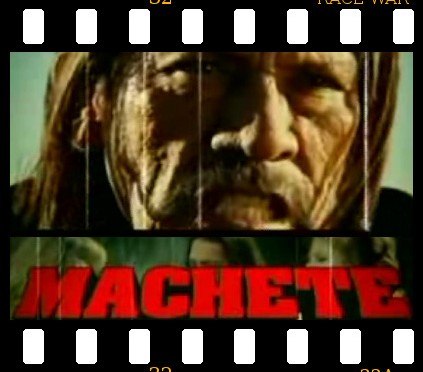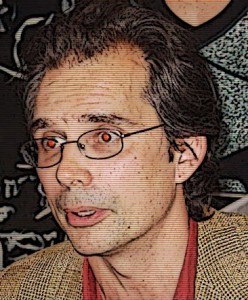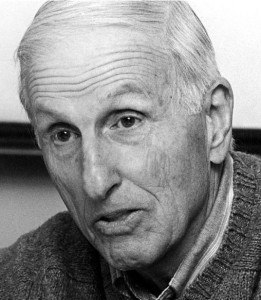Machete Trailer in Grindhouse, 2007. “This is MaCHETay, with a special Cinco de Mayo message…to Arizona!”, May 2010. Machete – Official Trailer [HD]. Viva Machete, promotional page.
Origins
Interview with Danny Trejo and director Robert Rodriguez for Machete:
Trejo: Well, this is a dream come true. Robert and I talked about it 14 years ago while we were doing Desperado and he just said, you know what, you’re perfect for this character. Here’s this script, here’s the storyline, and I thought wow man, it’s a dream movie.
Rodriguez echoes this story, and also reveals his filmmaking secret: create situations where nothing but accidents happen.
When the Revolution Comes
‘Machete’ Stars Pick Their Badass Allies, MTV Movie News:
Given the rebellious and revolutionary nature of Machete the character, and his trajectory in the film, we asked the stars who they would choose as an ally in a revolution.
“I’d have to say Danny [Trejo],” Rodriguez said. “You know why? Because he’s got loyalty in his eyes. He looks like the kind of guy that will take survival seriously, protection seriously, love seriously.”
Cheech Marin agreed: “Danny Trejo, man, he’s the baddest. He’s great in this movie.”
There you have it. Choice revolution ally: Danny Trejo.
Response from Hate Experts
site:adl.org machete rodriguez – “Mazel tov, we have a grudge against the blonde, blue-eyed devils too.”
site:splc.org machete rodriguez – “No comment.”
site:nclr.org machete rodriguez – “MaCHETay? Never heard of it.”
Lindsay Lohan Naked, in Threesomes in “Machete”, CBS News:
Star’s First Movie in Three Years Has Lohan Dressed as a Nun and Toting a Gun
Actress Lindsay Lohan is taking a baby step back into the Hollywood mainstream this weekend with her first movie in three years. She has a small part in the new film “Machete,” which opens today.
But can “Machete” cut-through all the bad press Lohan has gotten this year?
[Deputy online editor of The Hollywood Reporter Lindsay] Powers said, “In this movie, she has threesomes with her mother, she’s naked for a big chunk of time. She has a scene where her father picks her up from a drug den. So, it’s really hard to separate her real life and her acting right there.”
Interesting, isn’t it, what Lohan thinks she has to do to redeem herself in the eyes of Hollywood’s machers.
How Lindsay Lohan Got Her ‘Machete’ Part: Start With Her Blonde Hair, PopEater.com:
Lindsay Lohan can thank her long, blonde hair for helping her nab a memorable role in ‘Machete.’
Director Robert Rodriguez tells PopEater that he was approached by a producer friend, who urged him to cast Lohan in the movie he was making, which is based on the fake ‘Machete’ trailer that appeared in his 2007 co-venture with Quentin Tarantino, ‘Grindhouse.’
“I had this shot of Danny in the waterfall with the wife and daughter,” says Rodriquez. “You could see the wife’s face, but you can’t see the daughter’s. And I thought, that could be Lindsay. Just curl the hair. But that’s the classic shot of the trailer that everyone knows.”
From there, Rodriguez “reverse engineered” and came up with a storyline for Lohan around the character, who became a drug-using wild child that drives her father crazy with her antics.
“I made a fake poster of her with some guns [from] a picture of her off the Internet and stuck her in a nun’s habit, and I showed [Lindsay] the poster,” says Rodriguez. “And she said, ‘Alright, I’m in.'”
Now go scroll back up and watch that Grindhouse trailer.
Jessica Alba, Michelle Rodriguez Reveal Secrets Of ‘Machete’ Nude Scenes, MTV Movie News:
“I want to meet these guys who work in special effects and they are basically in charge of adding nipples,” Rodriguez added.
“No, no — there were no nipples, though!” Alba responded regarding her apparently post-production-enhanced shower.
“There weren’t?” Rodriguez asked, looking genuinely surprised. “I tried not to look because I thought that was a private moment that I shouldn’t be watching.”
“No, there was no nipple!” Alba insisted. “No, no, no, no nipple.”
Jessica Alba deftly defies stereotypes, tries out new roles, USATODAY.com:
“Working with a filmmaker that you believe in and that can push you, for me, was what I wanted to focus most on. And, it’s like, if I’m not going to spend time with my daughter, it has to be worth it.”
Apparently, Machete was well worth the time: It marks not only another chance to collaborate with Rodriguez but is also the half-Mexican Alba’s first Latina role.
She describes her immigration and customs enforcement officer character as “an intelligent, fierce, independent woman,” which made the role that much more appealing.
“For me, I never wanted to reinforce any stereotypes about Latin women, and that was why I’ve shied away from Latin characters I’ve been offered. Most of them reinforced the stigmas. The women whom I grew up with are intelligent, strong women, and unless I read a woman being portrayed that way in a film, I didn’t want to play it.
“There’s enough people that will reinforce those stereotypes, and I didn’t need to participate in that. This woman is just as fierce as the men, and so I’m proud to bring that to life and put that imagery in people’s heads.”
She deftly shied away from latina roles…until this dream come true of la raza solidarity came along.
Dull, Convoluted, Racist and Anti-American, John Nolte, Big Hollywood:
Still, “Machete” offers no middle ground, no reasonable, non-racist position against wide open borders for those fleeing from what one character describes as the “personal hell” that is Mexico.
Director Rodriguez attempts to disguise his toxic and racist message as something more accessible, the simple fight against DeNiro’s corrupt pol, his slimy aide (Jeff Fahey), and Steven Seagal’s Mexican drug kingpin. But this disguise doesn’t work. SHE’ is not a figure representing the fight for justice against injustice but rather of a coming and necessary revolution against America. Furthermore, when the Alba character stands on the hood of a car to kick off the film’s incredibly un-exciting and poorly choreographed race war climax, the war she calls for is not to stop violent racists but against an America (or Texas) that, in her delusional mind, is keeping people off land that is rightfully theirs (remember, the border crossed us).
And yet, never once does the movie bother to explain exactly what it is that makes America so special and attractive to those willing to risk their lives to get here. Can’t have that. Nor does anyone suggest that maybe the best place to wage revolution would be, I don’t know, that “personal hell” called Mexico. Can’t have that, either. Not when your protagonists are driven only by seething radical resentments, a misplaced sense of entitlement, and that warm, smug feeling of superiority that comes with assuming the role of the victim. But not victims of their own country, mind you, victims of America.
Hey, no one said hate had to make sense.
Who the illegals fight against on screen is one thing. What their words mean is altogether something else. That’s the shell game Rodriguez plays and his racially divisive messaging goes way beyond the normal cinematic political posturing and button-pushing. And you will never see a more stereotypically racist portrayal of Southerners, who, in an obvious reference to the border Minute Men, are not only played for cheap laughs but portrayed as sub-human animals who hunt and murder illegals – kill a helpless pregnant woman and say “Welcome to America.”
For the record, I believe in the American melting pot. My wife was born in Mexico, English is her second language, and she didn’t become an American citizen until she was in her twenties. For that reason, and others, my family is more racially diverse than the bus passengers in “Speed.” So I guess that what I’m really trying to say is, fuck you Robert Rodriguez.
What Nolte’s really trying to say is, I hate you Robert Rodriguez, for violating my otherwise blissful, deracinated worldview.
The Reconquista Is Here, James P. Pinkerton, FOXNews.com:
Meanwhile, Jessica Alba, playing an Hispanic Immigration and Customs Enforcement (ICE) agent, must wrestle with the tension between the requirements of her job and her loyalty to her ethnicity. “What’s the law and what’s right?” she asks. Guess which side she comes down on by the end of the movie.
The ending of the film, in fact, is a sort of mini-race war, a sort of “Mad Max”-like re-enactment of the Alamo, with the Mexicans, of course, winning once again–although this time, there are no noble defenders to be found.
Machete, Trevor Lynch, Counter-Currents Publishing:
It was gross, it was hilarious, and it communicated an important message: Mexico is a filthy, impoverished, backward, corrupt country inhabited by ugly, treacherous, cruel people. Mexicans are invading the United States, bringing Mexico with them. Mexicans corrupt every American who comes into contact with them, and their power to corrupt is so total that they even corrupt the patriots and politicians who oppose them.
In spite of their cruelty to one another, Mexicans pull together with a fierce solidarity when facing Americans, who are merely selfish individuals out to make or save a buck. People like that can always be bought off or intimidated. This solidarity gives Mexicans a vast support network in the United States—a network that includes the Catholic Church—which aids them in taking jobs from Americans, undercutting American wages, and leeching off American social services.
This movie is really all about making brutal and sadistic violence funny.
Yes, Machete delivers a warning to Arizona and the rest of America, but not the one its director intended. Machete portrays Mexicans as profoundly alien and threatening. It shows that their racial solidarity gives them an advantage over Americans, whose selfish individualism brought them here and keeps them here even though they are destroying our society. It shows our leaders as corrupt, sociopathic race traitors.
Lynch’s review of that recent judeo-race-war-porn film, Inglourious Basterds, was even better.
Capsule reviews of ‘The American,’ ‘Machete’ and ‘Going the Distance’, AP:
Robert Rodriguez extends the fake “Machete” trailer from his and Quentin Tarantino’s “Grindhouse” double-feature into a full-length revenge romp, maintaining a fair amount of the wicked humour and every bit of the savage bloodshed the make-believe ad promised. Danny Trejo stars as a former Mexican federal cop on a rampage of vengeance against drug dealers, brutal politicians and other bad guys. Viewers get precisely what they’re paying for: beheadings, skewerings and kill shots to the head by the dozen. They also get a crazy range of supporting players — Robert De Niro, Jessica Alba, Steven Seagal, Don Johnson, Michelle Rodriguez, Lindsay Lohan — all having a ball committing atrocities. Like most of Rodriguez’s movies, this one’s never as fun or funny as he thinks it is.
Sharp, Bloody Fun, Richard Corliss, TIME:
To be precise, it’s the action comedy the summer of 2010 has been promising for nearly four months but waited till Labor Day weekend to deliver. After the various disappointments and underperformances of Iron Man 2, Robin Hood, MacGruber, Prince of Persia, Killers, The A-Team, Knight & Day, The Sorcerer’s Apprentice, Salt, Scott Pilgrim vs. the World and The Expendables, audiences can be grateful for this lithe and knowing pastiche. It’s also, quite possibly, the first movie to be the remake of a trailer; Rodriguez created a promo for the then-fictional Machete as part of his Grindhouse collaboration with Quentin Tarantino. Maybe you remember a scene from that clip, in which Cheech Marin plays a priest called to arm himself against an angry mob? And when a man on the receiving end of Marin’s gun pleads for mercy, the padre replies, “God has mercy. I don’t,” and blasts away? Well, this Machete is that one plus about 90 more minutes of shooting, double-dealing and exploding heads — nonstop mayhem with a corpse count in the hundreds and a merry wink in every eye that hasn’t been sliced open.
(See the top 10 heroes and villains with machetes)
A salsa of every macho movie trope plied over the past half-century in films from Hollywood to Hong Kong, Machete hits U.S. theaters Friday but got its world premiere as the opening day’s midnight showing at the Venice Film Festival, where Hong Kong director John Woo will also be given a lifetime achievement award. That’s fitting, since, as Rodriguez has said, “When I watched John Woo’s movies, they made me want to be Asian. Woo and Chow Yun-fat’s Hard Boiled and The Killer really inspired me to make films that would create that feeling in the Latin arena.” Machete, which Rodriguez codirected with Ethan Marquis, is a giddy action film with a timely message: that Mexicans living in Texas, legally or not, can be heroes too. We need them to battle the purring gringo establishment that uses Latino immigrants both as a volatile race card and as cheap labor to prop up the Southwest economy.
(See TIME’s 25 most important films on race.)
The haves here are represented by three white guys in the private and public sector. Senator John McLaughlin (Robert De Niro, doing a Texas take on a Democrat’s worst nightmare of John McCain) is running for reelection on the Troglodyte platform: that “Every time an illegal crosses the border, it’s an act of terrorism against our state.” His political operative, Booth (Jeff Fahey, as a Karl Rove type with more up-front menace), hires Machete to assassinate McLaughlin, but of course it’s a ruse to make the Senator a hero and Machete the face of Latino terror. These two hard cases are in cahoots with a Mexican drug lord, Torrez (Steven Seagal), who in the first scene tries luring Machete with a beautiful woman, before shooting and him and killing her. Then there’s the vigilante lawman Stillman (Don Johnson), who sees a visibly pregnant woman at the border, observes, “If it’s born here, it gets to be a citizen, just like you and me,” and — Boom! —shoots the woman dead. One less illegal; one less terror baby.
Lindsay Lohan is here too, as a plutocrat’s pampered daughter who has a naked threesome with her mother and Machete. (If any idea, no matter how weird, pops into Rodriguez’s head, he says What the hell and films it.) Designed and destined to win no awards, Machete is expert, cartoon-violent, light-hearted fun. Just the thing to send Junior back to school in a good mood.
‘Machete’ Is A Great Gorefest! Plus Lindsay Lohan Gets Naked – AWESOME!, Russ Weakland, Hollywood Life:
When Robert Rodriguez makes a film, you should always expect the unexpected. So if you expected to have a peaceful, relaxing time at the movie theatre this Labor Day weekend, think again. Machete is blissful, bloody, fun carnage – but it sure as heck isn’t relaxing!
Danny Trejo plays an ex-Federale (a member of the Mexican police) who tries to clear his name after he’s made the fall guy on a crooked political assassination. Oh yeah, and he is PISSED. He wants revenge and will do whatever it takes to get it – including pretty inventive ways of killing those who have wronged him! Jessica Alba, Michelle Rodriguez, Lindsay Lohan, Cheech Marin and Robert DeNiro are all along for the ride on this blood and boobs filled bonanza that had me cheering in the theatre!
“Machete doesn’t text.” Ruth Starkman, who teaches film, literature, and philosophy at the University of San Francisco, and writes very somberly and soberly about post-war Germany and Martin Buber, loved this race-war film:
Surely Machete is an action hero for our times. The proud Mexican, dressed mostly as a worker, sometimes a leather biker, knife-throwing fighter, champion of oppressed immigrants.
Oppressed immigrants like guess who.
Blades of gory in ‘Machete’, NYPOST.com:
Phil Collins put the case succinctly: It’s no fun being an illegal alien. Except if you’re “Machete,” an ex-Mexican federal agent disguised as a Texas landscaper with a bloody mission to mow down Minuteman types with his mighty array of gardening tools.
Chased out of the country and across the border into Texas, Machete is hired by a shady businessman (Jeff Fahey) to assassinate a rabid state senator (Robert De Niro) who has been amping up the volume by denouncing illegals as “parasites,” complete with campaign commercials featuring creepy-crawly bugs. The businessman feels the senator has to be eliminated because he threatens to clamp down on the supply of cheap labor.
In his spare time, the senator turns vigilante with a sadistic Minuteman-like patrolman (Don Johnson) who enjoys driving along the border shooting any Mexicans they find sneaking into the country.
‘Machete’ a bloody good time, Katy Wagner, MOVE Magazine:
Despite favorable critical and audience praise, “Grindhouse” was by no means what Hollywood considers a success. Yet somehow, Rodriguez commandeered the financial backing to expand on a fake trailer attached to “Grindhouse” about a Mexican federale out for vengeance into another full-length throwback called “Machete.”
 Show Me the Money, or Lack Thereof
Show Me the Money, or Lack Thereof
Machete (2010), Box Office Mojo. This movie will by no means be what Hollywood considers a financial success, but of course there are other reasons movies get made.
Weekend Report: ‘The American’ Out-Draws The Mexican, Box Office Mojo:
Though it was barely first on Friday [3 Sept], Machete lost steam faster than The American and wound up in second with $14.1 million at 2,670 locations. It had a stronger start than Gamer from the same weekend last year, and its $11.4 million Friday-to-Sunday weekend wasn’t far behind its source, the box office bust Grindhouse. However, it did less than half the business of director Robert Rodriguez last straight-forward action picture, Once Upon a Time in Mexico. Distributor 20th Century Fox’s research showed that 55 percent of Machete’s audience was male, 55 percent was 25 years and older, and 60 percent was Latino.













